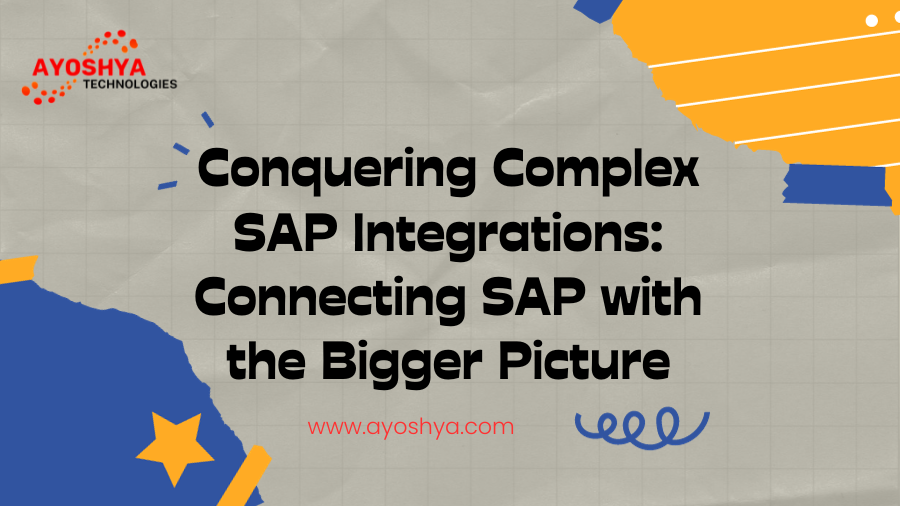Conquering Complex SAP Integrations: Connecting SAP with the Bigger Picture
Bridging the Divide: A Deep Dive into Mastering Complex SAP Integrations
In the bustling digital landscape, where data dances across disparate systems, SAP reigns supreme as the maestro of enterprise resource planning. But even the most exquisite concerto falters without seamless harmony between SAP and the symphony of applications that power modern businesses. This blog serves as your conductor, guiding you through the intricate complexities of Complex SAP Integrations, empowering you to connect, synchronize, and unlock the true potential of your data ecosystem.
Unveiling the Challenges: The Hidden Boulders on the Integration Path:
Before embarking on your integration odyssey, be prepared to navigate these unforeseen obstacles:
- Heterogeneous Landscapes: Modern businesses rarely rely solely on SAP. Integrating with diverse applications, databases, and cloud platforms demands sophisticated tools and expertise.
- Data Dissonance: Inconsistent data formats, structures, and governance across systems can lead to errors, discrepancies, and unreliable insights.
- Security Concerns: Ensuring secure data exchange and access control across integrated systems is paramount, demanding robust security protocols and encryption strategies.
- Performance Bottlenecks: Integrating complex systems can impact performance and scalability, requiring careful architecture design and optimization techniques.
- Maintenance Maze: Keeping integrations updated and functioning smoothly throughout evolving system landscapes becomes increasingly challenging as complexity grows.
Forging the Path: Unveiling the Integration Warriors:
But fear not, for every challenge a solution awaits:
- Integration Platforms as a Service (iPaaS): Leverage cloud-based platforms like SAP Cloud Platform Integration or SAP Leonardo to connect diverse systems without extensive in-house development.
- API Management: Employ API gateways to establish a single point of control for API access, authorization, and monitoring, streamlining data exchange and enhancing security.
- Data Cleansing and Harmonization: Utilize data integration tools to transform, extract, and consolidate data into a unified format, ensuring consistency and reliability across systems.
- Real-time Integration and Streaming: Implement technologies like SAP Event Mesh or microservices architectures to enable real-time data exchange and responsive workflows.
- DevOps and Automation: Adopt DevOps principles and automation tools to manage the integration lifecycle efficiently, minimize manual effort, and ensure ongoing stability.
Real-World Victories: Inspiring Case Studies in Integration Success:
Witness the transformative power of tackling integration challenges through compelling examples:
- A Global Manufacturing Giant: Implemented an iPaaS solution to integrate SAP with their supply chain management system, reducing inventory costs by 15% and improving delivery times by 20%.
- A Retail Leader: Utilized API management to connect their e-commerce platform with SAP S/4HANA, enabling real-time inventory updates and personalized customer experiences, leading to a 10% increase in online sales.
- A Pharmaceutical Company: Integrated SAP with their clinical research platforms using data harmonization tools, ensuring compliance with regulatory requirements and accelerating drug development processes.
Navigating the Evolving Landscape: Embracing the Future of Integrations:
The world of SAP integrations is constantly evolving, presenting new opportunities and challenges:
- Artificial Intelligence (AI) and Machine Learning (ML): AI-powered integration tools are emerging, promising to automate data mapping, optimize integrations, and even predict potential issues proactively.
- Cloud-Native Integrations: The shift towards cloud-based systems is accelerating, demanding expertise in cloud-specific integration tools and architectures.
- Microservices and Event-Driven Architecture (EDA): The rise of microservices and EDA necessitates agile and flexible integration approaches to handle fragmented applications and real-time data flows.
- Hyperconnectivity and the Internet of Things (IoT): Connecting SAP with IoT devices and diverse data sources presents exciting possibilities but also demands robust integration frameworks and security considerations.
The Final Accolade: Composing a Symphony of Success:
By conquering complex integrations, you unlock a symphony of benefits:
- Improved Data Visibility and Insights: Seamless data exchange across systems leads to richer insights, enabling data-driven decision-making and optimized business processes.
- Enhanced Agility and Efficiency: Automated integrations streamline workflows, reduce manual effort, and empower faster responses to changing market conditions.
- Boosted Customer Experience: Real-time data exchange and personalized interactions across touchpoints lead to more satisfied and loyal customers.
- Competitive Advantage: Integrating SAP with powerful external applications allows businesses to innovate faster, uncover new opportunities, and stay ahead of the curve.
Remember, successful integrations aren’t built overnight. They require careful planning, continuous learning, and a collaborative spirit. Foster a culture of integration awareness within your organization, invest in the right tools and expertise, and embrace the evolving landscape of connectivity. With dedication and foresight, you can transform the once daunting complexity of SAP integrations into a harmonious symphony of data flow, empowering your business to reach new heights of success. So, raise your baton, conduct your data with confidence, and let the music of seamless integration play on!
You may be interested in:
A Guide to Conquering the Oracle Certification Landscape



